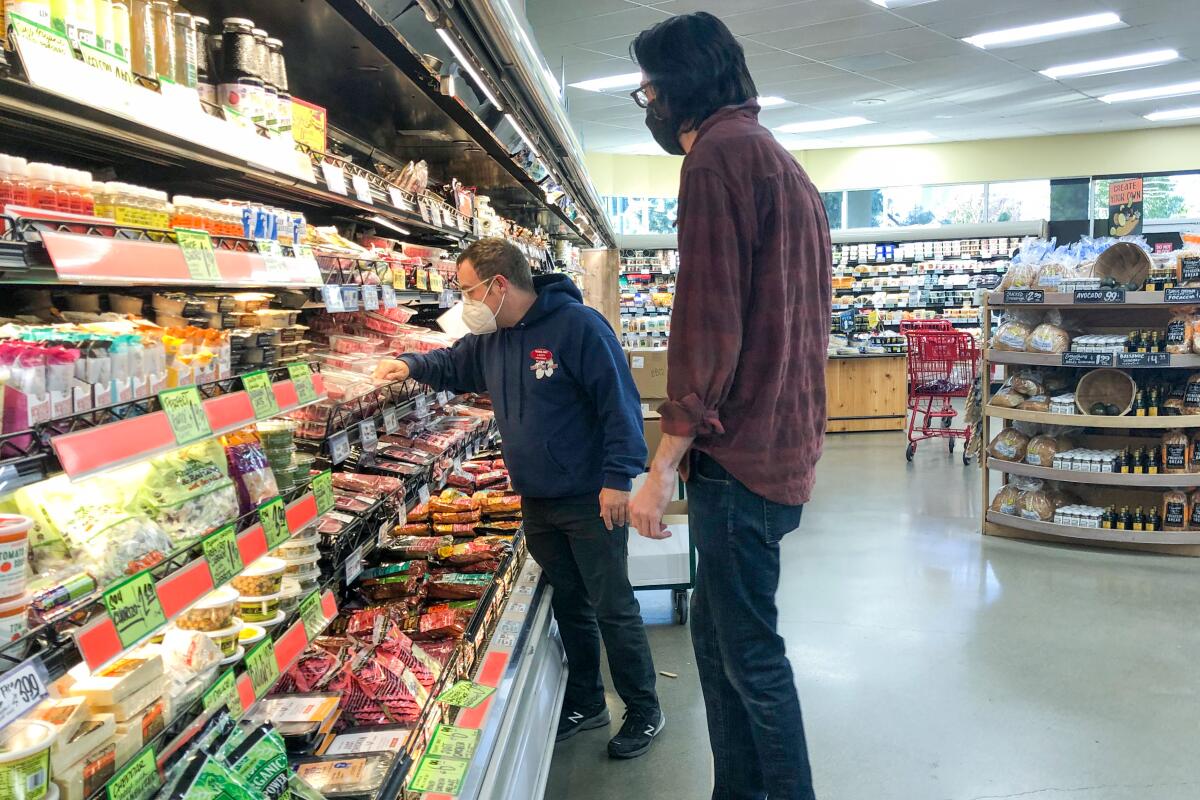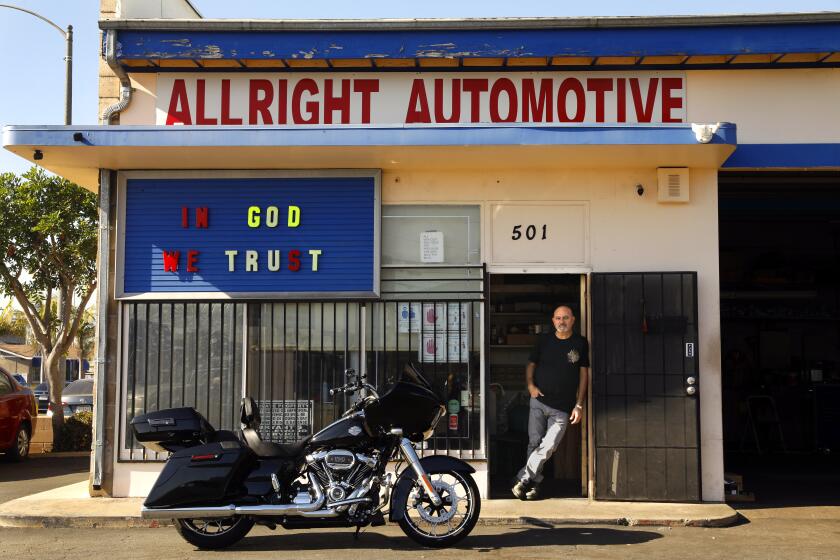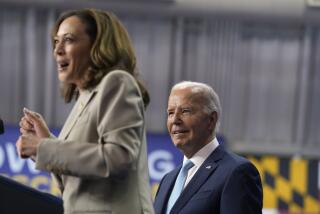Is the economy really that bad? Why inflation has the middle class so on edge

- Share via
WASHINGTON — At first, it was just a few things in the meat and produce sections that caught Gayle Stafford’s eye. But soon she noticed that prices were rising for soup and cereal. And it wasn’t just in the supermarket.
With overall inflation now running at a 40-year high of 7.5%, Stafford, a schoolteacher who lives outside Cincinnati, suddenly finds herself worrying about the family’s financial future, especially for her two adult kids.
“How are they going to be able to afford anything?” she asks, worried that surging inflation could price them out of the market for a house or other staples of the middle-class American dream.
Stafford and her husband, Gary, who works in tech support for grocers, have secure jobs that pay at or above the national median. Their lives have not been substantially affected by inflation.
Yet like millions of other Americans, including families with at least a modicum of financial security, inflation has suddenly become the dominant influence on their outlook, personally and politically.
For economists, the surge in public alarm over inflation is puzzling. By most measures, both the national economy and the personal economies of Americans are doing quite well. Gross domestic product rose last year at the fastest pace since 1984, recovering all of the output lost during the pandemic-induced recession in 2020.
California’s small businesses waded through COVID to a rebound in consumer spending, only to face rising costs for supplies and wages.
Moreover, the unemployment rate has fallen to 4%, and it was down to 2.8% most recently for the Cincinnati area. Real estate and other asset prices, which matter for homeowners like the Staffords, remain well above year-ago levels.
Even so, inflation appears to have an outsize impression on consumers’ attitudes, in part because unlike most other economic data, higher prices tend to have a direct and often visceral impact on people’s everyday lives.
Gayle Stafford, 55, could tell you almost exactly what the latest inflation rate is, and how that’s prompted her to drive a little farther away to buy groceries at discount stores. She’s taught herself to waste less and serve up more leftovers.
Her husband now buys sides of beef from a wholesale restaurant supplier to save the supermarket’s markup for preparing and packaging separate cuts.
They haven’t yet figured out similar strategies for dealing with the sudden upward spiral in the cost of heating their home. Their most recent monthly electricity bill was $460, about $100 more than a year earlier — just about the average 27% increase over last year in overall energy prices across the nation in January.
U.S. retail gasoline prices, on average, fell to less than $2 per gallon in the spring of 2020, but have since surged to $3.43. Those prices could go even higher if Russia invades Ukraine and its massive energy exports to the West are interrupted by U.S. and European sanctions.
“Inflation kind of more than cancels out all the good stuff,” said Jeff Jones, senior editor of Gallup, referring to consumer responses to public opinion polls about economic indicators.
But there’s another component that makes families like the Staffords feel a particular bite from inflation.
For all employees in the private sector, average hourly wages were up 5.7% in January over the last 12 months. Apart from a couple of months early in the pandemic, that is the fastest wage growth in at least 15 years. But the better pay was more than offset by inflation, which means most saw a loss of purchasing power.
And that was a startling and unsettling change after a decade or more of stability, during which wage gains generally were small but inflation was only about 2% per year.
Workers on the lower end of the income scale, who are hit hardest when inflation rises, have gotten the biggest bump up in earnings, especially in industries such as hospitality.
But middle-income households may feel as if they got pay cuts. Like other school districts facing labor shortages, Stafford’s system sharply boosted starting pay to attract new teachers, but veterans like her got raises that amounted to about 2%.
“I’m glad they’re increasing the starting pay and that retail workers are getting more, and the service industry too. That is absolutely necessary for a living wage,” Stafford said. “But what about the people that are the in-between — the non-rich people, the middle class or lower middle class?”
In the University of Michigan’s latest consumer survey this month, the sentiment index fell to a level not seen since the tail end of the Great Recession in 2009 when unemployment was nearly 10%.
Are things today that bad?
Clearly not, but the survey director, Richard Curtin, said consumers had gotten so used to living with subdued inflation that the sudden run-up in prices has been a shock. Most people living today, including millennials and Gen Xers before them, weren’t working or even born when the nation last had a serious bout of high inflation in the 1970s and early ‘80s.
“One of the untold stories,” Curtin said, “is that if you look at middle-income and households with a couple of kids, who have a big food budget and energy budget, their costs have increased proportionately more than others. And they have voiced more concern about rising inflation than either the younger or older folks, or the richer or poorer folks.”
Curtin and other economists worry that because of this phenomenon, more prime-age workers will be demanding bigger raises to keep up with prices, which could result in broader wage gains that in turn could trigger persistent inflation as companies pass on higher costs to consumers.
For now, Federal Reserve officials say they don’t yet see a wage price spiral. And the Fed is planning to raise interest rates starting next month in a bid to cool growth and lower the inflation rate, although many economists worry that policymakers are already behind the curve and could step on the brakes too hard and trigger a recession.
Ricky Volpe, an agribusiness professor at Cal Poly San Luis Obispo, says consumers are likely to get some relief on grocery prices soon.
Although pandemic-driven mismatches in supply and demand have had a role, Volpe said, food inflation should level off significantly because the weather conditions, always an important factor, have been better this past year in California and elsewhere. And agribusiness is responding to the widespread supply chain and labor shortage challenges.
Still, Volpe said, it may not do a whole lot for consumers’ mood or feelings about the economy. Food accounts for only about 13% of a typical household’s budget for goods and services, based on the weight in calculating consumer price inflation. But grocery spending seems to have an outsize effect on how they feel about their finances and economic conditions generally.
Moreover, while food prices may stop surging, they won’t be coming down, at least not any time soon. In January, the price of pork was up 14% from a year earlier, and beef rose even faster. Milk, a kind of bellwether item for families, went up 1.8% in a single month.
“People feel price increases; they don’t really feel price stagnation,” Volpe said.
Inflation also may be serving as a stand-in for other things people are unhappy about, including political polarization, deeper changes in society, and the seemingly endless pandemic.
“Even if gas continues to cost a little more and milk continues to cost a little more, but now I don’t have to wear a mask around and I can get together with my friends and do what I want, I might just be feeling better. And those negative feelings about the economy are not going to necessarily feel so negative anymore,” said Marc Hetherington, a political scientist at the University of North Carolina at Chapel Hill.
But Saria Hawkins-Banda, 30, who with her husband, Lewis, and their two young kids, isn’t so sure.
Like the Staffords, the Fort Worth family is solidly middle class, their incomes above the median $73,000 for that metro area.
Hawkins-Banda sees — and feels — the squeeze from inflation as a worker, consumer and small-business owner all wrapped in one.
She works full time in sales and project management for an educational tech company. She’s been able to work at home, saving money on gasoline and other expenses. And the couple took advantage of the housing boom and rock-bottom interest rates last year, refinancing their mortgage.
But neither she nor her husband, a physical therapist, got raises that kept up with inflation over the last 12 months.
In August 2020, Hawkins-Banda also launched an online business selling luxury office stationery and accessories tailored for Black women. Business at her firm, Manifest Your Purpose, has been good. She hired a part-time employee to help with marketing. And she’s sold out of her best product: stylized office journals.
But inflation has eaten away at her profits.
“Inflation has made journals that I used to pay $3 to buy wholesale, now they’re $4 or $5. So it’s like, how am I going to continue to turn a profit?” she said.
“You don’t want to lose money, but you don’t want to upset your customers,” said Hawkins-Banda, noting she’s a big consumer herself.
“Everything’s gone up. As a business owner, I understand that,” she said. “But as a consumer, it’s like, ‘Oh, my God. Why are these prices going up?’”
More to Read
Get the L.A. Times Politics newsletter
Deeply reported insights into legislation, politics and policy from Sacramento, Washington and beyond. In your inbox three times per week.
You may occasionally receive promotional content from the Los Angeles Times.












